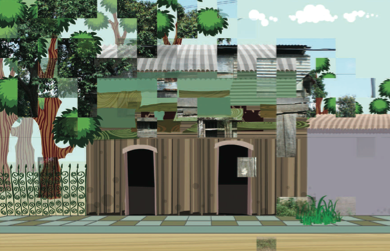6th Nicaraguan Visual Arts Biennial
The 6th Visual Arts Biennial of Nicaragua, inaugurated the past November at the Rubén Darío Theater in Managua, exhibited a selection of works by 17 artists encompassing all disciplines and ranging from intimist drawings (Emilia Membreño) through a video that excerpted and called into question images from a local television program (Gema Hernández), to installations made from waste materials brought from the largest dump in the city (Edwin Mauricio Mejía). The show, which comprised 25 works, confirmed that, as the Belgian critic Thierry de Duve stated, “at present it is technically possible and institutionally legitimate to make art out of anything and everything”.
An important presence in the small art scene of a small country, the Biennial, organized by the Ortiz-Gurdián Foundation is already an influential institution that develops a cultural program including lectures, meetings among artists, parallel exhibitions – like the one presented by Orlando Sobalvarro, to whom this edition was dedicated –, and sends six Nicaraguan artists to the Central American Visual Arts Biennial. This latter admirable private endeavor includes the participation of 36 artists from the Region (six award-winners per country) and it is held alternatively in El Salvador, Costa Rica, Honduras, Nicaragua, Panama and Guatemala; the forthcoming edition will take place in Honduras in 2008.

The jury comprised of Mónica Kupfer (Panama), José Noceda (Cuba) and the author of this article, from Argentina, unanimously awarded First Prize to Espíritu, by Wilbert Carmona, a work based on an Internet site. The artist decided to produce this work when a friend introduced him to a website, http://poodwaddle.com/worldclockes.htm, that made him shudder and caused him to envision life from a different perspective. The work consisted in the projection in real time of the mentioned site, which ceaselessly records figures associated to the world population (births, deaths, illness); nature (deforestation, oil extraction); consumer goods (automobile production, computers). Number after number, at each moment it documents how AIDS, cancer or old age causes the death of thousands of people. The viewer had to take a number before entering the installation space, and on his or her way out, press a button that announced the turn of the next visitor on a digital screen. Thus, through cold and conclusive statistics, the artist gave evidence of the fragility of existence.
The Second Prize was awarded to Cristina Cuadra for Columpio Mombacho, a sensitive proposal that showed a swing and photographic documentation of the impressive installation (with the help of the Fire Brigade of the city of Granada) of the mentioned swing in “a natural crevice, in one of the eco-tourism trails in the Mombacho Volcano Ecological Reservation, with the aim of playing inside the Earth, in response to the tellurian force represented by a volcano”.
The four Honorable Mentions – which also carried a prize in cash and participation in the Central American Biennial – were awarded to Ricardo Miranda Huezo for his interactive work Casas, that brought to the forefront the contradictions of the urban landscape (Managua was never reconstructed after the 1972 earthquake, which devastated 75 % of the city), and the social context. The pleasant-looking façade shown on the screen continually changed and ugliness and dwelling deficiencies were revealed as the viewer moved the mouse. Marcos Agudelo earned a distinction for his object, Desintegración 0.1, which through the language of craftsmanship – a woven basket featuring a half- disassembled map of Nicaragua–, reinvented the Nicaraguan cartography on the basis of fragmentation and displacement. Other award winners were Rossana Lacayo ́s short film, Equívoco, and Zeneila Roiz ́s video, Son las mías. On the other hand, Fernando Moroney ́s discreet denouncement regarding the calamitous state of the School of Art and the neglect of its authorities, conveyed through his work Un día cualquiera (www.chiripa.wordpress.com), produced such a reaction of fury that his expulsion from the premises was considered.







